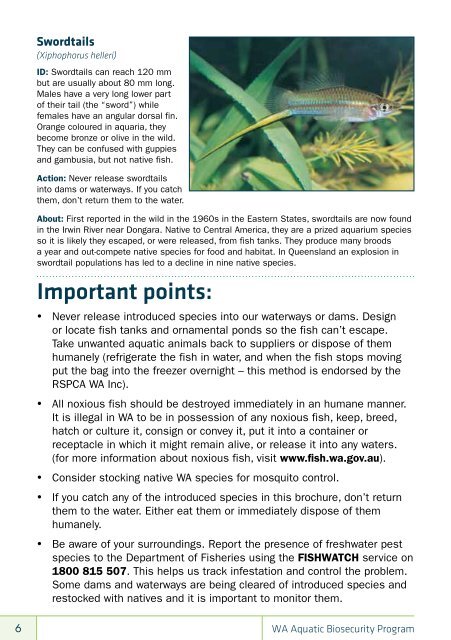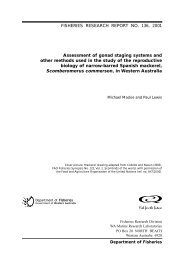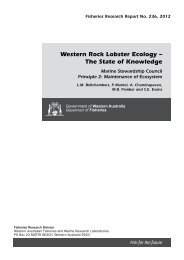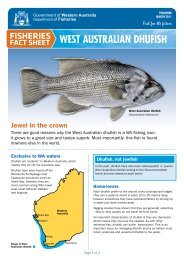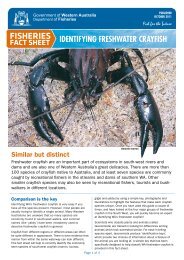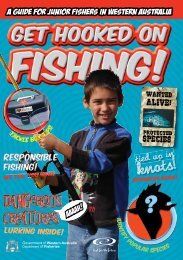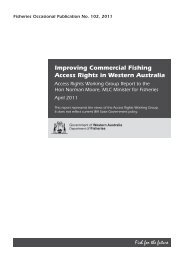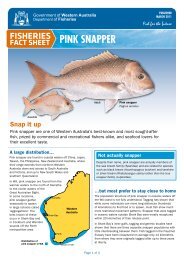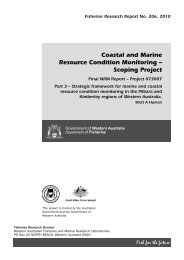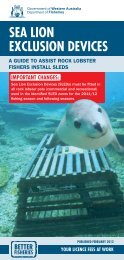aquatic invaders identification guide - Department of Fisheries
aquatic invaders identification guide - Department of Fisheries
aquatic invaders identification guide - Department of Fisheries
Create successful ePaper yourself
Turn your PDF publications into a flip-book with our unique Google optimized e-Paper software.
6<br />
Swordtails<br />
(Xiphophorus helleri)<br />
ID: Swordtails can reach 120 mm<br />
but are usually about 80 mm long.<br />
Males have a very long lower part<br />
<strong>of</strong> their tail (the “sword”) while<br />
females have an angular dorsal fin.<br />
Orange coloured in aquaria, they<br />
become bronze or olive in the wild.<br />
They can be confused with guppies<br />
and gambusia, but not native fish.<br />
Action: Never release swordtails<br />
into dams or waterways. If you catch<br />
them, don’t return them to the water.<br />
About: First reported in the wild in the 1960s in the Eastern States, swordtails are now found<br />
in the Irwin River near Dongara. Native to Central America, they are a prized aquarium species<br />
so it is likely they escaped, or were released, from fish tanks. They produce many broods<br />
a year and out-compete native species for food and habitat. In Queensland an explosion in<br />
swordtail populations has led to a decline in nine native species.<br />
Important points:<br />
Never release introduced species into our waterways or dams. Design<br />
or locate fish tanks and ornamental ponds so the fish can’t escape.<br />
Take unwanted <strong>aquatic</strong> animals back to suppliers or dispose <strong>of</strong> them<br />
humanely (refrigerate the fish in water, and when the fish stops moving<br />
put the bag into the freezer overnight – this method is endorsed by the<br />
RSPCA WA Inc).<br />
All noxious fish should be destroyed immediately in an humane manner.<br />
It is illegal in WA to be in possession <strong>of</strong> any noxious fish, keep, breed,<br />
hatch or culture it, consign or convey it, put it into a container or<br />
receptacle in which it might remain alive, or release it into any waters.<br />
(for more information about noxious fish, visit www.fish.wa.gov.au).<br />
Consider stocking native WA species for mosquito control.<br />
If you catch any <strong>of</strong> the introduced species in this brochure, don’t return<br />
them to the water. Either eat them or immediately dispose <strong>of</strong> them<br />
humanely.<br />
Be aware <strong>of</strong> your surroundings. Report the presence <strong>of</strong> freshwater pest<br />
species to the <strong>Department</strong> <strong>of</strong> <strong>Fisheries</strong> using the FISHWATCH service on<br />
1800 815 507. This helps us track infestation and control the problem.<br />
Some dams and waterways are being cleared <strong>of</strong> introduced species and<br />
restocked with natives and it is important to monitor them.<br />
WA Aquatic Biosecurity Program


